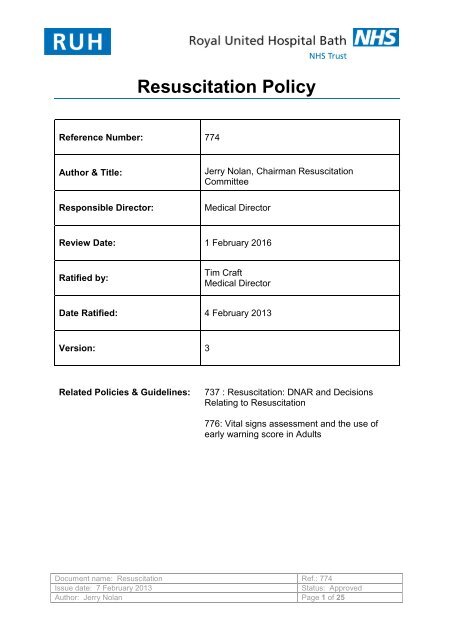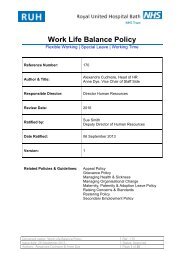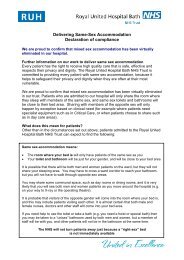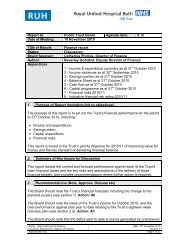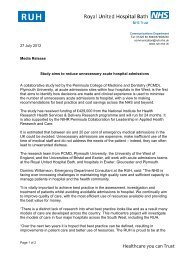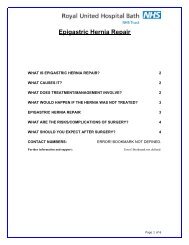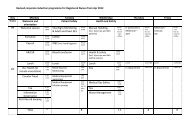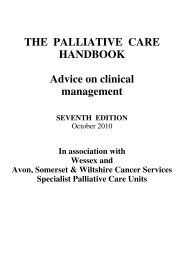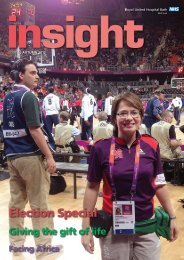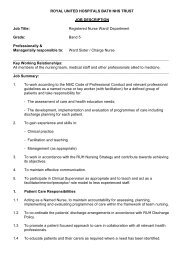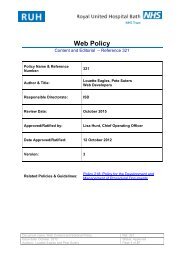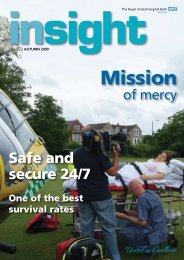Resuscitation Policy - Royal United Hospital Bath NHS Trust
Resuscitation Policy - Royal United Hospital Bath NHS Trust
Resuscitation Policy - Royal United Hospital Bath NHS Trust
Create successful ePaper yourself
Turn your PDF publications into a flip-book with our unique Google optimized e-Paper software.
<strong>Resuscitation</strong> <strong>Policy</strong>Reference Number: 774Author & Title:Responsible Director:Jerry Nolan, Chairman <strong>Resuscitation</strong>CommitteeMedical DirectorReview Date: 1 February 2016Ratified by:Tim CraftMedical DirectorDate Ratified: 4 February 2013Version: 3Related Policies & Guidelines:737 : <strong>Resuscitation</strong>: DNAR and DecisionsRelating to <strong>Resuscitation</strong>776: Vital signs assessment and the use ofearly warning score in AdultsDocument name: <strong>Resuscitation</strong> Ref.: 774Issue date: 7 February 2013Status: ApprovedAuthor: Jerry Nolan Page 1 of 25
Index:1. Introduction __________________________________________________ 32. <strong>Resuscitation</strong> Committee _______________________________________ 33. <strong>Resuscitation</strong> Training Department _______________________________ 44. <strong>Resuscitation</strong> Training _________________________________________ 55. The <strong>Resuscitation</strong> Team ________________________________________ 66. <strong>Resuscitation</strong> of Children _______________________________________ 77. <strong>Resuscitation</strong> Equipment _______________________________________ 88. Decisions Relating Cardiopulmonary <strong>Resuscitation</strong> _________________ 99. Patient Transfer and Post <strong>Resuscitation</strong> Care ______________________ 910. Monitoring and Audit __________________________________________ 1011. External <strong>Trust</strong>s Located on the RUH Site _________________________ 1112. Review _____________________________________________________ 11Appendix 1: Escalation of Treatment Flow Chart _____________________ 12Appendix 2: Contents of Paediatric <strong>Resuscitation</strong> Trolley ______________ 13Appendix 3: Contents of Paediatric <strong>Resuscitation</strong> Drug Box ____________ 15Appendix 4: Procedure for Checking <strong>Resuscitation</strong> Trolley Equipment ___ 16Appendix 5: Contents of Adult <strong>Resuscitation</strong> Trolley __________________ 18Appendix 6: Content of Adult <strong>Resuscitation</strong> Box _____________________ 20Appendix 7: Guidelines for the Removal of <strong>Resuscitation</strong> Equipment fromICU Central Store _________________________________________________ 21Document Control Information ______________________________________ 23Ratification Assurance Statement _____________________________________ 23Consultation Schedule _______________________________________________ 24Equality Impact: (A) Assessment Screening ____________________________ 25Amendment HistoryIssue Status Date Reason for Change Authorised2 Approved March 2010 Planned Review OperationalGovernanceCommittee3 Approved 4 February2013Planned ReviewTim CraftMedical DirectorDocument name: <strong>Resuscitation</strong> Ref.: 774Issue date: 7 February 2013Status: ApprovedAuthor: Jerry Nolan Page 2 of 25
1. Introduction1.1 This policy covers aspects of cardiopulmonary resuscitation (CPR)administration, training and practice undertaken at the <strong>Royal</strong> <strong>United</strong> <strong>Hospital</strong><strong>NHS</strong> <strong>Trust</strong>.1.2 The policy is based on: Cardiopulmonary <strong>Resuscitation</strong> – Standards forClinical Practice and Training – A joint statement from the <strong>Royal</strong> College ofAnaesthetists, the <strong>Royal</strong> College of Physicians of London, the Intensive CareSociety and the <strong>Resuscitation</strong> Council (UK).1.3 A separate policy, entitled <strong>Resuscitation</strong> - DNAR and Decisions Relating to<strong>Resuscitation</strong>, covers the ethics of resuscitation in general and do-notattempt-resuscitation(DNAR) orders specifically.2. <strong>Resuscitation</strong> Committee2.1 The resuscitation committee meets quarterly. The <strong>Resuscitation</strong> committee’sterms of reference are review yearly and can be accessed on request to theresuscitation committee.2.2 Once approved, minutes and will be stored electronically and available tosupport CQC and <strong>NHS</strong>LA standards.2.3 <strong>Resuscitation</strong> committee will report to Operational Governance Committee(OGC) in line with OGC reporting request.2.4 The chair of the resuscitation committee should be a consultant with an activeand credible involvement in resuscitation.2.5 Membership details are set out in the terms of reference and include the leadresuscitation officer, cardiologist, emergency physician, paediatrician,pharmacist, medical physics representative, and a senior manager.Membership of the committee will be reviewed each year and agreed as partof the Terms of reference.2.6 The resuscitation committee’s responsibilities are set out in the terms ofreference and include:• Ensuring adherence to national resuscitation guidelines and standards• Defining the role and composition of the resuscitation team• Ensuring the resuscitation equipment for clinical use is available• Ensuring appropriate resuscitation drugs (those for peri-arrest situations) areavailable• Planning adequate provision of training in resuscitationDocument name: <strong>Resuscitation</strong> Ref.: 774Issue date: 7 February 2013Status: ApprovedAuthor: Jerry Nolan Page 3 of 25
• Determining requirements for and choice of resuscitation training equipment• All policies relating to resuscitation and anaphylaxis• The 737: <strong>Resuscitation</strong>: DNAR and Decisions Relating to <strong>Resuscitation</strong> policy• Audit of resuscitation outcomes and implementation of policy 737• Recording and reporting critical incidents in relation to resuscitation3. <strong>Resuscitation</strong> Training Department3.1 At a minimum, there should be enough resuscitation trainers to meet thetraining needs for the RUH <strong>NHS</strong> <strong>Trust</strong>. This is in line with ‘Cardiopulmonary<strong>Resuscitation</strong> – Standards for Clinical Practice and Training – A jointstatement from the <strong>Royal</strong> College of Anaesthetists, the <strong>Royal</strong> College ofPhysicians of London, the Intensive Care Society and the <strong>Resuscitation</strong>Council (UK)’.3.2 Additional resuscitation officers may be employed to meet the requirements oftraining contracts outside of the RUH <strong>NHS</strong> <strong>Trust</strong>.3.3 The duties of the Senior <strong>Resuscitation</strong> Officer (<strong>Resuscitation</strong>/Clinical skillsTraining Manager) focus on being a professional resource and advisor onresuscitation and include: follow up reports of incidents relating to cardiacarrests or other clinical emergencies; providing de-briefing for staff; providinga visible and accessible resource in clinical settings; co-ordinating thepurchase of clinical emergency equipment and its distribution across the <strong>Trust</strong>site; leading on the development, promotion and evaluation of <strong>Trust</strong> clinicalpolicies and procedures; and actively participating as a member of the <strong>Trust</strong><strong>Resuscitation</strong> Committee. These duties will be monitored by report to the<strong>Resuscitation</strong> Committee.Document name: <strong>Resuscitation</strong> Ref.: 774Issue date: 7 February 2013Status: ApprovedAuthor: Jerry Nolan Page 4 of 25
6. <strong>Resuscitation</strong> of Children6.1 The paediatric resuscitation team is summoned, by calling 2222, for childrenin cardiopulmonary arrest or where the outcome is threatened. The teamleader should be someone with expertise and training in the resuscitation ofchildren. For neonates requiring or likely to require resuscitation, the neonatalresuscitation team (paediatric registrar and senior house officer) is summonedby calling 2222.6.2 At least one member of the paediatric resuscitation team should possess avalid certificate in Advanced Paediatric Life Support (APLS) or EuropeanPaediatric Life Support (EPLS).6.3 Training in basic paediatric and neonatal life support, recognition of the sickchild and prevention of cardiac arrest will be available for clinical staff who areexpected to attempt resuscitation of children or neonates. This will includestaff working in areas where children are inpatients or attend as outpatients.6.4 Dedicated standardised trolleys will be available in all areas where childrenare likely to be treated. The equipment kept on these trolleys is listed inAppendix 2. The drugs kept in the paediatric resuscitation box are listed inAppendix 3. Areas where neonates are likely to be treated will providespecialized equipment.6.5 A paediatric grab-bag will be located on the children’s ward and will be takenby ward staff (nursing or medical) to any paediatric emergency outside of theChildren’s Unit.6.6 A paediatric bag-mask device will be located on the Eye Unit, OrthopaedicOutpatients, Oral Surgery, and Physiotherapy Department and in the NuclearMedicine Department – all other paediatric equipment will be removed fromthe adult resuscitation trolleys in these areas.6.7 Parents or carers of high-risk children will be offered resuscitation training, butonly if approved by a paediatric consultant. The training will be delivered onlyby those who attended the ‘Parental Training – Train the Trainer Course’ runby the <strong>Resuscitation</strong> Department.Document name: <strong>Resuscitation</strong> Ref.: 774Issue date: 7 February 2013Status: ApprovedAuthor: Jerry Nolan Page 7 of 25
7. <strong>Resuscitation</strong> Equipment7.1 Defibrillators are located strategically throughout the <strong>Trust</strong> to enable shockdelivery within 3 minutes of a patient’s collapse anywhere on the site.7.2 The make and model of defibrillator should be standardised throughout the<strong>Trust</strong>. All emergency defibrillator equipment should be purchased with theconsent and agreement of both the <strong>Resuscitation</strong> and Medical EquipmentCommittees, and MEMS.7.3 Defibrillators should be checked in line with manufacturer’s instructions by therelevant ward/departmental staff. The procedure for this is detailed inAppendix 4.7.4 Standardised adult resuscitation trolleys are used throughout the <strong>Trust</strong>. Thecontents of each resuscitation trolley are listed in Appendix 2 (Paediatric) andAppendix 5 (Adult).7.5 Each resuscitation trolley contains a standardised cardiac arrest drug box thecontents of which are listed in Appendix 3 (Paediatric) and 6 (Adult).7.6 After each resuscitation attempt, cardiac arrest drug boxes and defibrillationpatches should be replaced from the central store outside the Intensive CareUnit (ICU) Replacement equipment is issued in exchange for a completedcardiac arrest audit form. Guidelines for the removal of equipment from theICU store are given in Appendix 7.7.7 <strong>Resuscitation</strong> trolleys must be checked at least weekly and after each use. Arecord of these checks must be maintained and kept on the ward or clinicalarea for a minimum of a year. An annual rolling programme of audit ofresuscitation trolley checks will be undertaken, as identified in the auditprogramme, and the records must be available for audit when necessary.7.8 The checking of resuscitation equipment is also included in the Matron’sscorecard quarterly report.Document name: <strong>Resuscitation</strong> Ref.: 774Issue date: 7 February 2013Status: ApprovedAuthor: Jerry Nolan Page 8 of 25
10. Monitoring and Audit10.1 Cardiac arrest audit data will be collected with an audit form being completedafter each resuscitation attempt. The completed form should be left in theresuscitation store outside ICU. Data from this form will be extracted for entryinto the National Cardiac Arrest Audit (NCAA). The RUH NCAA data will bereviewed by the <strong>Resuscitation</strong> Committee at least annually and comparedwith national NCAA data. Any areas of risk will be assessed by the<strong>Resuscitation</strong> Committee.10.2 DNAR documentation will be audited every two years and results reviewed bythe <strong>Resuscitation</strong> Committee, in order to identify compliance with the DNARpolicy.10.3 <strong>Resuscitation</strong> Trolley equipment will be audited by the <strong>Resuscitation</strong>Department annually and results reviewed by the <strong>Resuscitation</strong> Committee, inorder to identify areas of non-compliance and assist wards/departments toimprove practice.10.4 Training records will be reviewed at least annually by the <strong>Resuscitation</strong>Committee, in order to respond to and prioritise supply and demand foraccess to training and determine key areas of risk through non-attendance.10.5 Information on reported incidents relating to resuscitation will be reported tothe <strong>Resuscitation</strong>/Clinical Skills Training Manager, in order to identify areas ofrisk/non-compliance, informing the development of training programmes andpolicy development.10.6 The <strong>Resuscitation</strong>/Clinical Skills Training Manager will report to eachresuscitation committee, detailing information on compliance with this policy,audit reports, incident reporting and areas of risk identified including actionstaken.10.7 Information on the analysis of audit data, benchmarking and the identificationof areas of risk will form part of the resuscitation committee reports to theOperational Governance Committee.Document name: <strong>Resuscitation</strong> Ref.: 774Issue date: 7 February 2013Status: ApprovedAuthor: Jerry Nolan Page 10 of 25
11. External <strong>Trust</strong>s Located on the RUH Site11.1 Any <strong>Trust</strong> responsible for patients based on the RUH site is stronglyencouraged to comply with this policy. Responsibility for staff training andrecords, availability of standardised equipment, equipment maintenance,ability to call the resuscitation team via switchboard all lie with the individual<strong>Trust</strong>. However, the <strong>Resuscitation</strong> Department personnel at the RUH areavailable for advice.12. ReviewThis policy will be subject to a planned review every 3 years as part of the <strong>Trust</strong>’s<strong>Policy</strong> Review Process. It is recognised however that there may be updates required inthe interim, arising from amendments or release of new regulations, Codes of Practiceor statutory provisions or guidance from the Department of Health or professionalbodies.Document name: <strong>Resuscitation</strong> Ref.: 774Issue date: 7 February 2013Status: ApprovedAuthor: Jerry Nolan Page 11 of 25
Appendix 1: Escalation of Treatment Flow ChartDecision made about frequency of vital signs assessment (made by medical team aspart of management plan, local ward standards or as part of care plan)Monitoring plan delivered as agreed. Consider trigger reset if treatment optimal or ifchronic ill health makes threshold of 4 unsuitable (experienced nurse / doctor only)EWS = 0EWS = 1-2EWS = 3Observe (no immediate action)Observe (HCA must report observations & score tonurse)Repeat Respiratory Rate recording, Pulse, Bloodpressure, Oxygen saturation, GCS or AVPUCalculate urine output for last two hours (if known)Recalculate EWSIf the same observe closely(HCA must report observations and score to nurse)ConsiderOutreach orNNP supporton grounds ofclinicalconcern onlyEWS = 4Level of doctorcontacted willvary in differentareasEnsure that all treatment options have been used.Repeat Respiratory Rate recording, Pulse, Bloodpressure, Oxygen saturation, GCS or AVPURecalculate EWSEnsure that EWS trigger has not been re-setContact doctor immediately (according to local protocol)(HCA must report observations and score to nurse)Considercritical careoutreach ornight nursepractitionersupportEWS greaterthan 4Patient is at risk of deterioration and complications. Iftreatment plan is not appropriate or in place escalatetreatment with urgency and seek medical reviewRESUSCITATION TEAM CALLING CRITERIAON FINDING ANYONE INOR• Cardiac arrest• Respiratory arrest• Unrousable / not responding to painWith one or more of the following signs:• Respiratory rate < 8 per minute• Respiratory rate > 30 per minute• Heart rate < 40 per minute• Heart rate > 150 per minute• BP < 90 systolic• Oxygen saturation < 90% Dial 2222If EWS ishigh, suddendeteriorationis likely.Document name: <strong>Resuscitation</strong> Ref.: 774Issue date: 7 February 2013Status: ApprovedAuthor: Jerry Nolan Page 12 of 25
Appendix 2: Contents of Paediatric <strong>Resuscitation</strong>TrolleyTop of TrolleyDefibrillator and monitoring leadsTags to secure trolleyOne set of paediatric defibrillator padsFolder containing check list, sign sheets for checking/ordering equipment,defibrillator check sheet, paediatric emergency drug doses, algorithm.Paediatric bag-mask device, plus additional size 2 face maskSharps binLatex free glovesStethoscopePortable Suction next to trolleyOxygen with tubing and non-rebreathing maskFirst DrawerRazorSpare set of paediatric defibrillator padsECG electrodes x 6ScissorsSecond DrawerSteretsNeoflons yellow x 5Venflons blue, pink, green x 5 of eachSyringes 1 ml, 2 ml, 5 ml, 10 ml x 5 of each, 20 ml, 50 ml x 2 of eachGreen, blue, orange needles x 5 of eachSaline ampoule 10 ml x 5Water ampoule 10 ml x 5Venflon caps/Bionectors x 53 way tap with extension set x 2Gauze,IV dressing/vecafixTape – MicroporeBlood gas syringes x 2Third Drawer1L 0.9% saline500 ml 10% dextroseIO needles 15 and 18 gIV giving set with buretteNon-rebreathing mask – paediatricSuction catheters sizes 6, 8 x 2 of eachYankauer suction catheters child and adult x 1 of eachDocument name: <strong>Resuscitation</strong> Ref.: 774Issue date: 7 February 2013Status: ApprovedAuthor: Jerry Nolan Page 13 of 25
Lower CupboardInfant airway boxPaediatric airway boxPaediatric emergency drug boxPaediatric intubation drug boxContents of Airway BoxesInfant airway box (age 0 – 1, up to 10 Kg) containing:Tracheal tube uncuffed size 2.5 - 4.0 mmLaryngoscopeLaryngoscope blades disposable straight size 0 & 1Facemask shaped 00, 0, and 1NG tube size 6, 8Tape to tie tubeAquagelStylet/introducer smallGuedel airways sizes 00, 0, 1Catheter mountChild disposable Magill forcepsPaediatric airway box (age 1 – 8, weight 10 – 24 Kg) containing:Tracheal tubes uncuffed 4.5 – 6.5 mmGuedel airways sizes 1, 2, and 3.LaryngoscopeLaryngoscope blades disposable curved size 1 & 2Facemask size 1 and 2NG tube size 8, 10Tape to tie tubeAquagelStylet/introducer largeCatheter mountAdult disposable Magill forcepsDocument name: <strong>Resuscitation</strong> Ref.: 774Issue date: 7 February 2013Status: ApprovedAuthor: Jerry Nolan Page 14 of 25
Appendix 3: Contents of Paediatric <strong>Resuscitation</strong>Drug BoxAdrenaline injection 1 in 1000Adrenaline injection 1 in 10,000Amiodarone injection 50 mg/mlAtropine sulphate injection 600 mcg/mlCalcium gluconate injection 10%Sodium bicarbonate injection 8.4%5 x 5 ml ampoule5 x 10 ml IMS syringe12 x 3 ml amp2 x 1 ml amp2 x 10 ml amp4 x 10 ml ampDocument name: <strong>Resuscitation</strong> Ref.: 774Issue date: 7 February 2013Status: ApprovedAuthor: Jerry Nolan Page 15 of 25
Appendix 4: Procedure for Checking <strong>Resuscitation</strong>Trolley EquipmentAll equipment must be checked by a member of staff who has received theappropriate training from the <strong>Resuscitation</strong> Department or a competent member ofstaff. It is for the Sister/Manager in charge of the ward/department to decide whothis will be. If you are unsure of any of the equipment or procedures or experienceany problems, please contact a member of the <strong>Resuscitation</strong> Department onExtension: 1173.1. Defibrillatora) This must be checked daily by a member of staff who is competent to do so.The checking procedure includes ensuring DEFIBRILLATOR PADS AREPRESENT and the defibrillator is clean and dust free.b) A weekly operational check must also be performed.Tests must be recorded on a Defibrillator Checking sheet. This should be kepton the ward for a minimum of 4 months and be available for the Sister and/or<strong>Resuscitation</strong> Officer to audit. If the test is unsuccessful or you experiencetechnical difficulties, please inform Medical Equipment Management Service(MEMS) IMMEDIATELY on Extension: 4140.2. Trolley ContentsThe contents of the trolley must be checked weekly, or immediately after use. Thiscan be performed by any member of staff who has been shown how to do so.• CHECK EXPIRY DATES ON ALL EQUIPMENT.• CHECK ALL EQUIPMENT IS COMPLETE; CHECK MASK ON BAG-VALVE-MASK IS COMPLETE.The contents should match the equipment list. Please DO NOT over stock. Thetrolley is meant for emergency use only and other equipment can be gathered whenneeded.All non-stock items can be obtained from the equipment store in the ITU corridor. Inparticular, please keep only 2 sets of defibrillator pads, as these expire quite quickly.The checking procedure includes ensuring the trolley and contents are clean anddust free.3. Other EquipmentThis must also be checked weekly. Equipment to be checked includes:Portable OxygenDocument name: <strong>Resuscitation</strong> Ref.: 774Issue date: 7 February 2013Status: ApprovedAuthor: Jerry Nolan Page 16 of 25
The cylinders should be at least half full, with a suitable length of oxygen tubingattached. Please cut this on the bubble, so that it can be attached to masks orbag/valve/mask assembly quickly.Portable SuctionEnsure that this is clean and dust free with all connections attached. Patient tubingof a suitable length must be attached. Check that suction is adequate by ‘kinking’tubing and watching dial rise. Any problems please inform MEMS on Extension:4140.Wall Oxygen and SuctionWhere this is in use, this must be checked as above. Please ensure that lengths oftubing are adequate to reach from the appliance to the patient.Pocket MasksThese must be situated in every patient area. They should not be placed on theArrest Trolley, as they are intended for use whilst this is being obtained. After use,the masks can be washed. The valves should be replaced from the ITU cupboard.Please ensure that masks are secured to walls. Brackets for this purpose areavailable for departments to purchase. Please contact <strong>Resuscitation</strong> Training fordetails.Please record all checks on the appropriate form. Equipment checking formsmust be kept on the ward for a minimum of 4 months and be available for theSister and/or <strong>Resuscitation</strong> Officer to audit.The <strong>Resuscitation</strong> Department Team is available for help and advice onExtension: 1173 or 4186.Document name: <strong>Resuscitation</strong> Ref.: 774Issue date: 7 February 2013Status: ApprovedAuthor: Jerry Nolan Page 17 of 25
Appendix 5: Contents of Adult <strong>Resuscitation</strong> TrolleyTOP OF TROLLEYDefibrillator1 set of appropriate defibrillator pads1 Box of medium latex free disposable gloves1 Sharps bin1 Defibrillator procedures packTOP DRAWER1 Spare set of defibrillator pads1 Roll of ECG recording paper1 pair of scissors1 surgical razorSECOND DRAWER5 x 20ml Syringes10 x 10 ml SyringesNeedles: 10 Green (21 GA), 2 Orange (25 GA)Venflons: 5 x Green (18 GA), 5 x Orange (14 GA), 5 x Pink (20 GA)5 x I.V Cannulae Dressing10 Sterets10 Chloroprep 0.67 ml vial1 x disposable Scalpel3/0 Mersilk Suture x 12 x Blood Gas Syringes1 Roll of Micropore tape.2 x Packs of gauze swabs10 x 10ml Normal Saline (flush)THIRD DRAWER2 x 1000 ml Normal Saline1 x Oxygen mask1 x Oxygen mask with reservoir5 x size 12 flexible suction catheters2 x Yankauer suction catheters2 x Blood giving setsLOWER CUPBOARD1 x Disposable Bag-mask device1 x Box of Emergency Drugs(** Drug boxes required outside office hours may be replaced from the store **)1 x Box of airway management equipment (see below for contents)1 x Box of green oxygen tubingDocument name: <strong>Resuscitation</strong> Ref.: 774Issue date: 7 February 2013Status: ApprovedAuthor: Jerry Nolan Page 18 of 25
• Items in bold type are available for restocking from the central store located inthe ITU corridor.• Items in italics are available from pharmacy• All other items should be replaced from your own storesPLEASE DO NOT OVERSTOCK!!ITEMS ON THE ARREST TROLLEY ARE FOR EMERGENCY USE ONLYAIRWAY MANAGEMENT EQUIPMENTThis box should contain:1 each Guedel Airway size 2, 3 and 41 each nasopharyngeal airway size 6 and 71 x catheter mountLaryngoscope with size 3 Macintosh blade1 each tracheal tube size 6, 7 and 81 x 10ml syringeLubricating JellyTube Tie1 pair adult Magill’s forcepsAudit FormFOR REPLACEMENT PLEASE RETURN TORESUSCITATION STORE AFTER USEDocument name: <strong>Resuscitation</strong> Ref.: 774Issue date: 7 February 2013Status: ApprovedAuthor: Jerry Nolan Page 19 of 25
Appendix 6: Content of Adult <strong>Resuscitation</strong> BoxAdrenaline injection 1 in 10,000 (1 mg in 10 ml)Amiodarone 300 mgs in 10 mlCalcium chloride 10%Magnesium Sulphate 10% (8 mmol in 20 ml)6 x 10 ml IMS syringe1 x 10 ml IMS syringe1 x 10 ml IMS syringe2 x 10 ml ampsDocument name: <strong>Resuscitation</strong> Ref.: 774Issue date: 7 February 2013Status: ApprovedAuthor: Jerry Nolan Page 20 of 25
Appendix 7: Guidelines for the Removal of<strong>Resuscitation</strong> Equipment from ICU Central StoreResponsibilities of ward/department staff• It is the responsibility of ward/department staff to ensure the correct equipment ispresent on the resuscitation trolley, as set out in the red folders provided by theresuscitation department.• It is the responsibility of ward/department staff to ensure the correct equipment isselected from the cupboard, regardless of whether the equipment was collectedby porters or ward/department staff.• If the workload makes it difficult to collect equipment for a resuscitation trolley thisshould be addressed immediately by the nurse in charge who may need to gethelp from another department or the senior nurse bleep holder for their area.• Any issues relating to resuscitation: equipment, procedures, practice, incidents,training should be referred to the <strong>Resuscitation</strong> Department by the staff memberin charge of that shift or manager of the ward/department in conjunction with anyother processes or procedures that are hospital policy and appropriate.Drug Boxes• During pharmacy opening hours if an emergency drug box is used it will need tobe returned directly to pharmacy to get a replacement.• Out of hours if a drug box is used, return it to pharmacy in the ward/departmentpharmacy box. If the department does not have a pharmacy box it can bereturned in person as soon as pharmacy is open again.• Used boxes should NOT be returned to the ITU cupboard.• Out of hours if a new drug box is needed it will be collected from the resuscitationcupboard in ITU. Its number must be recorded, the old signing out book has beenremoved and a column added to the <strong>Resuscitation</strong> Equipment RemovalRecord.• If the number is not recorded ITU will be automatically charged for the drugsused.Missing or out of date equipment: responsibilities of ward/department staff• If equipment is missing or out of date on the trolley it is the responsibility ofward/department staff to collect the equipment from the cupboard, not theporters. An audit form is not needed but the <strong>Resuscitation</strong> Equipment RemovalRecord should be completed (in the yellow folder).Document name: <strong>Resuscitation</strong> Ref.: 774Issue date: 7 February 2013Status: ApprovedAuthor: Jerry Nolan Page 21 of 25
New equipment after a resuscitation event: responsibilities of ward/departmentstaff• If equipment is needed after a cardiac arrest, collecting new equipment can bedelegated to the portering staff. It is the responsibility of ward/department staff toensure the equipment needed is written on the audit form and the form given tothe porter.Responsibilities of ITU Staff• ITU staff are responsible for opening the cupboard for the porters, selecting andgiving the equipment to them as per the audit form completed by theward/department staff.• ITU staff need to collect a completed audit form from the porters and put it in thedesignated place.• ITU staff are responsible for opening the cupboard to ward/department staff butwill not select equipment for them.New equipment after a resuscitation event: responsibility of portering staff• Porters will collect equipment for ward/department staff after a peri/cardiac arrestif they are given a completed audit form. ITU staff will open up the cupboard andselect the correct equipment for them, according to what has been requested bythe ward/department staff on the audit form.Equipment available for collection from the ITU cupboardITEMSQuantity stocked in ITU cupboardBag- mask-device Min 15Red airway box Min 15Phillips adult plus multifunction Min 20electrode padsPhillips paediatric plus multifunction Min 10electrode pads3/0 Mersilk suture 1 boxOxygen mask with reservoir 15Drug box (from cupboard only when 5 in addition to pharmacy supplypharmacy is shut)Defibrillator printer paper20 rollsValve for pocket mask 20Document name: <strong>Resuscitation</strong> Ref.: 774Issue date: 7 February 2013Status: ApprovedAuthor: Jerry Nolan Page 22 of 25
Document Control InformationRatification Assurance StatementDearTimPlease review the following information to support the ratification of the below nameddocument.Name of document: <strong>Resuscitation</strong> <strong>Policy</strong> (Reference 774)Name of author:Jerry NolanJob Title:I, the above named author confirm that:Chairman, <strong>Resuscitation</strong> Committee• The <strong>Policy</strong> presented for ratification meets all legislative, best practice and other guidanceissued and known to me at the time of development of the <strong>Policy</strong>;• I am not aware of any omissions to the <strong>Policy</strong>, and I will bring to the attention of the ExecutiveDirector any information which may affect the validity of the <strong>Policy</strong> presented as soon as thisbecomes known;• The <strong>Policy</strong> meets the requirements as outlined in the document entitled <strong>Trust</strong>-wide <strong>Policy</strong> forthe Development and Management of Policies (v4.0);• The <strong>Policy</strong> meets the requirements of the <strong>NHS</strong>LA Risk Management Standards to achieve asa minimum level 2 compliance, where applicable;• I have undertaken appropriate and thorough consultation on this <strong>Policy</strong> and I havedocumented the names of those individuals who responded as part of the consultation withinthe document. I have also fed back to responders to the consultation on the changes made tothe <strong>Policy</strong> following consultation;• I will send the <strong>Policy</strong> and signed ratification checklist to the <strong>Policy</strong> Coordinator for publicationat my earliest opportunity following ratification;• I will keep this <strong>Policy</strong> under review and ensure that it is reviewed prior to the review date.Signature of Author: Date: 1 February 2013Name of PersonRatifying this policy: Tim CraftJob Title:Medical DirectorSignature: Date: 4 February 2013To the person approving this policy:Please ensure this page has been completed correctly, then print, sign andpost this page only to: The <strong>Policy</strong> Coordinator, John Apley Building.The whole policy must be sent electronically to: ruh-tr.policies@nhs.netDocument name: <strong>Resuscitation</strong> Ref.: 774Issue date: 7 February 2013Status: ApprovedAuthor: Jerry Nolan Page 23 of 25
Consultation ScheduleName and Title of IndividualDate ConsultedDawn Fairclough, <strong>Resuscitation</strong> and Clinical Skills 14/01/2013LeadLynn Garland, <strong>Resuscitation</strong> and clinical skills22/01/2013managerDavid Skirrow, Pharmacist 22/01/2013Neil Boyland, Senior Nurse 22/01/2013Julian Hunt, Consultant Nurse 22/01/2013Hilary Maddicks, Consultant Paediatrician 22/01/2013Dominic Williamson, Consultant emergency medicine 22/01/2013Lindsay Grant, Consultant Clinical Scientist 22/01/2013Kevin Carson, Consultant 22/01/2013Joanne Miller, Assistant Director of Nursing 22/01/2013Robert Elliott, Lead for Quality Assurance 22/01/2013William Hubbard, Director Medical Division 22/01/2013Monica Baird, Director Surgical Division 22/01/2013Tracy Elvins, Head of Learning and Development 29/01/2013The following people have submitted responses to the consultation process:Name and Title of IndividualDate RespondedDawn Fairclough, <strong>Resuscitation</strong> and Clinical Skills 14/01/2013LeadDominic Williamson, Consultant emergency medicine 22/01/2013Monica Baird, Director Surgical Division 22/01/2013Lynn Garland, <strong>Resuscitation</strong> and clinical skills23/01/2013managerJulian Hunt, Consultant Nurse 28/01/2013Tracy Elvins, Head of Learning and Development 29/01/2013Name of Committee/s (if applicable)Date ofCommitteeDocument name: <strong>Resuscitation</strong> Ref.: 774Issue date: 7 February 2013Status: ApprovedAuthor: Jerry Nolan Page 24 of 25
Equality Impact: (A) Assessment ScreeningTo be completed when submitted to the appropriate Executive Director forconsideration and approval.Person responsible for the assessment:Name:Job Title:Jerry NolanChairman <strong>Resuscitation</strong> CommitteeDoes the document/guidance affect onegroup less or more favourably than anotheron the basis of:Yes/NoCommentsRace Yes NoEthnic origins (including gypsies and travellers) Yes NoNationality Yes NoGender (including gender reassignment) Yes NoCulture Yes NoReligion or belief Yes NoSexual orientation Yes NoAge Yes NoDisability(learning disabilities, physical disability, sensory impairment andmental health problems)YesNoIs there any evidence that some groups are affecteddifferently?Yes NoIf you have identified potential discrimination, are thereany valid exceptions, legal and/or justifiable?Yes NoIs the impact of the document/guidance likely to benegative?Yes NoIf so, can the impact be avoided? Yes NoWhat alternative is there to achieving thedocument/guidance without the impact?Yes NoCan we reduce the impact by taking different action? Yes NoIf you answered NO to all the above questions, the assessment is now complete, and nofurther action is required.If you answered YES to any of the above please complete theEquality Impact: (B) Full AnalysisDocument name: <strong>Resuscitation</strong> Ref.: 774Issue date: 7 February 2013Status: ApprovedAuthor: Jerry Nolan Page 25 of 25


